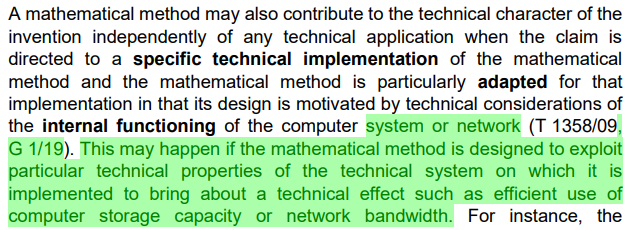Like every year around this time, the EPO updates their Guidelines for Examination. The new Guidelines will come into effect on 1 March, and the EPO has made a draft preview available here. Some significant updates include an overhaul of the section on computer simulations following the G1/19 decision (see here for a summary). Any changes for AI? Nothing major this year, but some changes are worthy of note. These changes may be good to think about for practitioners in terms of adapting how we present our arguments for AI inventions.
There has been some minor updating of the wording in the section on mathematical methods (G-II-3.3.), which holds the key to arguing the patentability of AI inventions. As I explained before, there are two routes to patentability, technical application and technical implementation of AI. You can read more about what this means here and here. I have spotted six changes and, on the whole, believe that they are favourable for applicants seeking protection for AI inventions. So what exactly changed?
Technical Application
Change #1

This change clarifies that it must be the technical effect produced by the method (the effect of the features distinguishing the method over the state of the art) that serves a technical purpose. This looks minor but is an important qualification. An example of the difference between the method serving a technical purpose and the technical effect serving a technical purpose can be found in T1635/19 (which I have discussed here). In short, it is not enough that the method serves a technical purpose, but it must be the technological improvement over the state of the art that does. In the example of T1635/19, the method served a technical purpose. Yet, the Board dismissed the appeal because it was not convinced by the alleged technical effect.
Change #2

This is a welcome clarification; the change clarifies that using a mathematical method to measure the physical state indirectly means that the mathematical method makes a technical contribution that needs to be considered for analysing inventive step.
Change #3
A reference has been added to section G-II-3.6.4 of the Guidelines as an example where improvement computational efficiency qualifies as a technical effect serving a technical purpose. The technical purpose here is database management, which the EPO added last year as a technical field after being treated as abstract software for a long time (when will it be AI's turn, I recently wondered here?)
Change #4
The EPO Guidelines provide examples of how one should analyse inventive step for inventions having a mix of technical and non-technical features in G-II-5.4.2. In the draft Guidelines, the EPO has added an example related to a high-level application of AI invention (as new section G-II-5.4.2.5 on page VII-19 of the Guidelines). Given that the invention here is based on the combination of a "neural network" and "neuro-fuzzy control" without further details, the conclusion (no inventive step) is not that surprising. Incidentally, this example is closely based on T1968/08, which I have discussed last month here.
Technical Implementation
Change #5

In the reality of EPO examination practice, some examiners have interpreted the "specific technical implementation" recited in this part of the guidelines as requiring the claims to be limited to special-purpose hardware. I have previously argued that this is not required by the relevant Board of appeal case law (and indeed, the case law does not mention a "specific technical implementation"). While it is a shame that this section of the Guidelines has not been overhauled to be more in line with the case law, the added example is welcome. It provides an explanation of "design […] motivated by technical considerations of the internal functioning of the computer". Hopefully, it will shift the focus to this aspect, which is strongly supported by case law.
Change #6

While this added example is quite specific, it does underline the point touched on above for change #4. CPUs and GPUs are found in most general-purpose computers, and so this example usefully illustrates that special purpose hardware is not required.